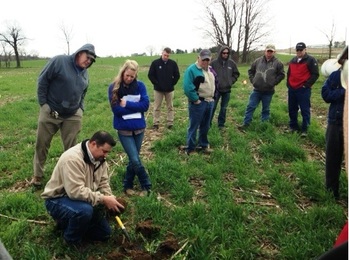|
Spring is officially here! Flowers are blooming, the
weather is warming up and farmers are getting out into the fields to plant. As busy as this season is for many of us, it’s also an excellent time to
promote agriculture and help consumers better understand what’s happening on
the farm and in the industry.
Whether you're a member of the agricultural community, or an agriculture
enthusiast, there are many ways to promote the industry this spring. Here are
five ways to get you started:
-
Instagram: A picture is worth a thousand words! Instagram is here to help us tell our
agriculture stories in pictures. Snap a photo on your phone while planting,
doing field work, working with farmers or wherever your agricultural
adventures take you this spring. NOTE: don’t forget to include a caption
to explain what’s happening in the photo since those outside of
agriculture may not know what is taking place.
-
Social Media: People want to know where their food comes from, and social media is a great tool to help us reach consumers! If you have a
personal Facebook page, blog, Twitter account or any other social media
platform, use it to show and tell what you are up to this spring in
agriculture.
-
Everyday conversations: Don’t forget about the importance of those everyday
conversations. Talk about what you’ve been up to and help connect those
outside of agriculture to what is happening on the farm and in the
industry this time of year. The grocery store, dentist’s office and other
places are great for these conversations.
-
Farm tours: With a fervor of activities taking place, now is a great time of the year to host a farm tour. You could invite school children out to the
farm for a field trip to learn more about agriculture, or perhaps a local civic organization or elected officials. People love to see things firsthand, so this is a great way to explain and show what
you are doing, how you are doing it and why.
-
Lose the industry jargon: Regardless of how you are promoting agriculture,
make sure you are speaking in a language that consumers can understand.
That means not using industry jargon and terminology. If you must use a
specific term, make sure to define it. To bridge the gap, we need to meet
consumers where they are and connect what we are talking about to what
they already know.
There are many strategies and methods that can help farmers get ahead during growing season, but how many of those strategies are personalized? How many of those methods are free? Better yet, how many involve an expert opinion?
 INfield Advantage (INFA) is a fitting name for a program
that gives growers the upper hand. By gathering and analyzing personalized,
field-specific data, the purpose of INFA is to help participants improve
their understanding of how nitrogen is used within the framework of their particular operation, which
includes field history, rotations and nutrient management.
|
INFA focuses on regional groups that range anywhere
between 10 to 20 growers. The groups are led by a local leader, which can
consist of an ISDA or Soil and Water Conservation District staff member, who
assist the participants and help them enroll their fields into the
program. On average, most growers sign up anywhere from 2 to 6 fields.
Once in the program, there many tools available to the
participants that can provide insight into their nitrogen management practices
including:
- Corn stalk nitrate testing: This will allow
participants to determine nitrogen use efficiency at the end of the
growing period.
- Aerial imagery: This will allow participants
to discover possible issues, including soil compaction and equipment
malfunctions.
- Replicated strip trials: This will allow
participants to compare different rates, forms, timing and placement of
crop nutrients within a single field to evaluate nutrient efficiency and
associated yield.
While there are many advantages to participating in INFA,
one of the biggest is the local winter grower meeting. This brings together
local participants with an agronomic consultant who are able to discuss their
findings and share best practices moving forward. It’s important to note that
the individual field reports are kept anonymous and the locations are
generalized to protect the grower’s information during the meeting.
Registration has begun for 2016, so for more information as well as case studies, please visit www.infieldadvantage.org.
INfield Advantage is available to Indiana crop farmers thanks
to: Indiana Soybean Alliance, Indiana Corn Marketing Council, Indiana State
Department of Agriculture, Indiana Association of Soil and Water Conservation
Districts, Purdue Extension, Indiana Conservation Partnership and USDA Natural
Resources Conservation Service.
Recently, ISDA members attended a cover crop field day in
Hendricks County. This was a great opportunity for staff to learn more about
the benefits of using cover crops, the process of selecting species and mixes,
and different weed suppression techniques. It was also a valuable opportunity
for growers, who were interested in learning more about the benefits of cover
crops, to connect with other growers who are experienced in using them.

The field day included a visual examination of the soil to spot
differences in coloration based on cover crop usage, as well as a discussion of
root growth and nutrient production. The group learned that cover crops
can be thought of like a "winter blanket for your field" and that
they can reduce erosion, improve soil quality by increasing organic matter
and water retention capacity, and help retain nutrients, to list a few.
ISDA is an advocate for the use of cover crops, and through our
Division of Soil Conservation and the Indiana Conservation Partnership, technical and educational assistance is available
to growers considering cover crops. Additionally, the Midwest Cover Crop
Council, of which Purdue is a member,
also provides useful information for both new and experienced users of cover
crops.
According to a study by Feeding Indiana’s Hungry and Feeding America, 1 in 6 people in Indiana, or an estimated 1.1 million, turn to food pantries and meal service programs to feed themselves and their families. Addressing the issue of food insecurity is complicated and no easy task. It is not just about getting enough food, but rather ensuring it is healthy and nutritious food, which can be a daily struggle for low-income families. However, some initiatives, like Growing Opportunities, are working hard to address this issue in order to improve the lives of Hoosiers.
To achieve this, they are actively raising awareness about the importance of good nutrition and cooking on a regular basis. They also provide information to help low-income families incorporate more nutrient-dense foods into their diets, such as herbs and leafy greens – both specialty crops.
Working to accomplish a similar goal is Growing Places Indy. They offer specialty crop focused educational opportunities, such as cooking, nutrition and gardening classes, to youth and adults, as well as classes about season extension practices. Additionally, they are working to increase access to nutritious specialty crops for individuals and families living in low food access areas of Indianapolis.
So, what do both of these initiatives have in common? They were awarded grants through the Specialty Crop Block Grant program and have been using those funds to achieve their goals.
The program is administered by ISDA and was established to help fund projects to enhance the competitiveness of Indiana’s specialty crops. Through the United States Department of Agriculture (USDA), funds are available to nonprofits, producers, academic institutions and government agencies, to name a few, and ISDA is currently accepting applications until June 6.
If approved, these grants can be used to develop a local or regional food system, or improve food access in underserved communities. They could also be used to develop new as well as improved seed varieties and specialty crops. Investing in specialty crop research, including research to focus on conservation and environmental outcomes, is another possible objective. Click here to see the full list.
If you, or someone you know, might be interested in applying, please visit www.in.gov/isda/2474.htm or contact Hannah Ferguson at hferguson@isda.in.gov. Grant proposals are due June 6, 2016 by 5:00 p.m. (EST).
Note: USDA's Agricultural Marketing Service defines specialty crops as "fruits, vegetables, tree nuts, dried fruits and horticulture and nursery crops (including floriculture)." Eligible plants must be intensively cultivated and used by people for food, medicinal purposes and/or aesthetic gratification. A list of specialty crops is available, along with a companion list of ineligible commodities, on USDA’s website.
|